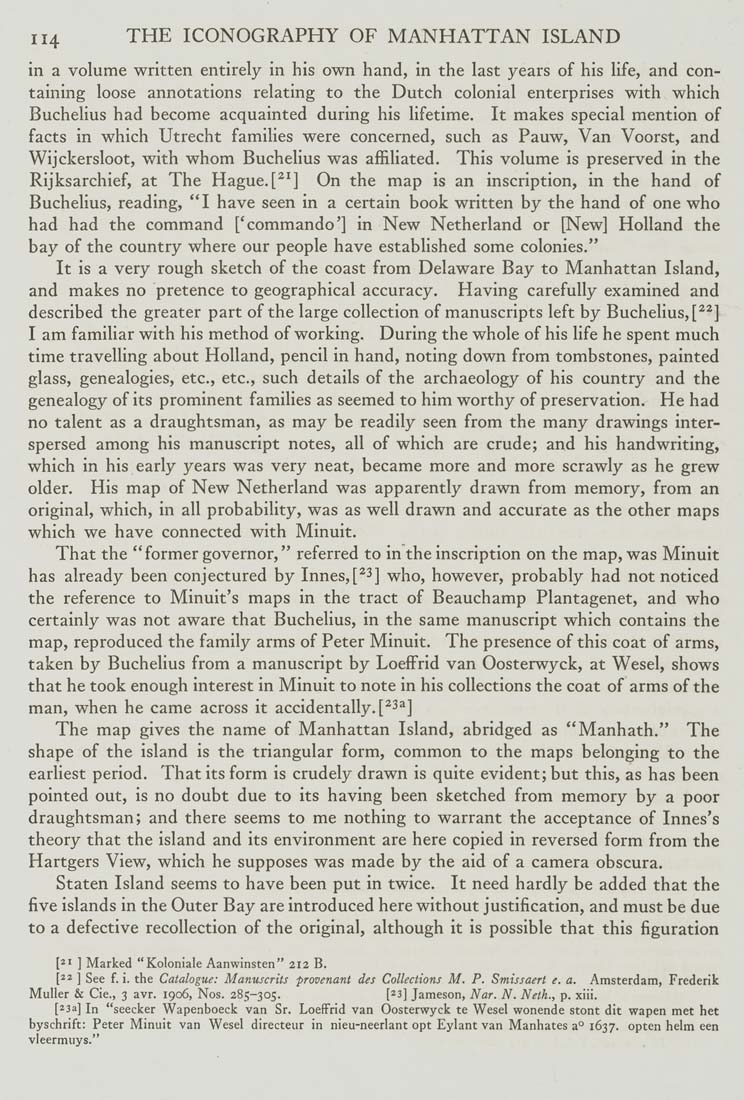114 THE ICONOGRAPHY OF MANHATTAN ISLAND
in a volume written entirely in his own hand, in the last years of his life, and con¬
taining loose annotations relating to the Dutch colonial enterprises with which
Buchelius had become acquainted during his lifetime. It makes special mention of
facts in which Utrecht families were concerned, such as Pauw, Van Voorst, and
Wijckersloot, with whom Buchelius was affiliated. This volume is preserved in the
Rijksarchief, at The Hague.[^'] On the map is an inscription, in the hand of
Buchelius, reading, "I have seen in a certain book written by the hand of one who
had had the command ['commando'] in New Netherland or [New] Holland the
bay of the country where our people have established some colonies."
It is a very rough sketch of the coast from Delaware Bay to Manhattan Island,
and makes no pretence to geographical accuracy. Having carefully examined and
described the greater part of the large collection of manuscripts left by Buchelius, [^^]
I am familiar with his method of working. During the whole of his life he spent much
time travelling about Holland, pencil in hand, noting down from tombstones, painted
glass, genealogies, etc., etc., such details of the archaeology of his country and the
genealogy of its prominent families as seemed to him worthy of preservation. He had
no talent as a draughtsman, as may be readily seen from the many drawings inter¬
spersed among his manuscript notes, all of which are crude; and his handwriting,
which in his early years was very neat, became more and more scrawly as he grew
older. His map of New Netherland was apparently drawn from memory, from an
original, which, in all probability, was as well drawn and accurate as the other maps
which we have connected with Minuit.
That the " former governor," referred to in the inscription on the map, was Minuit
has already been conjectured by Innes,[^3] -who, however, probably had not noticed
the reference to Minuit's maps in the tract of Beauchamp Plantagenet, and who
certainly was not aware that Buchelius, in the same manuscript which contains the
map, reproduced the family arms of Peter Minuit. The presence of this coat of arms,
taken by Buchelius from a manuscript by LoefFrid van Oosterwyck, at Wesel, shows
that he took enough interest in Minuit to note in his collections the coat of arms of the
man, when he came across it accidentally. [^3a]
The map gives the name of Manhattan Island, abridged as "Manhath." The
shape of the island is the triangular form, common to the maps belonging to the
earliest period. That its form is crudely drawn is quite evident; but this, as has been
pointed out, is no doubt due to its having been sketched from memory by a poor
draughtsman; and there seems to me nothing to warrant the acceptance of Innes's
theory that the island and its environment are here copied in reversed form from the
Hartgers View, which he supposes was made by the aid of a camera obscura.
Staten Island seems to have been put in twice. It need hardly be added that the
five islands in the Outer Bay are introduced here without justification, and must be due
to a defective recollection of the original, although it is possible that this figuration
[21 ] Marked "Koloniale Aanwinsten" 212 B.
[22 ] See f. i. the Catalogue: Manuscrits provenant des Collections M. P. Smissaert e. a. Amsterdam, Frederik
Muller & Cie., 3 avr. 1906, Nos. 285-305. [23] Jameson, Nar. N. Neth., p. xiii.
[23a] In "seecker Wapenboeck van Sr. Loeffrid van Oosterwyck te Wesel wonende stont dit wapen met het
byschrift: Peter Minuit van Wesel directeur in nieu-neerlant opt Eylant van Manhates a° 1637. opten helm een
vleermuys."
|








